Fast App: AM Yields Better Product Results
By testing new products with additive manufacturing prototypes, products are assured a better design and longer working life.
Latest News
April 9, 2013
By Alyssa Parkinson
The latest development in thermal imaging cameras from FLIR Systems is a small, sleek camera for boaters to use as nighttime vision aids. The camera, dedicated to the average boater, functions as a fixed seeing eye.
“Navigating at night and actually seeing what is in front of you helps boaters, firefighters, the Coast Guard,” explains Marcel Tremblay, director of mechanical engineering at FLIR. “GPS tells you where the boat is, and radar will detect what is far in front, but the camera actually shows you what is there. The camera is like your own eyes in the daytime.”
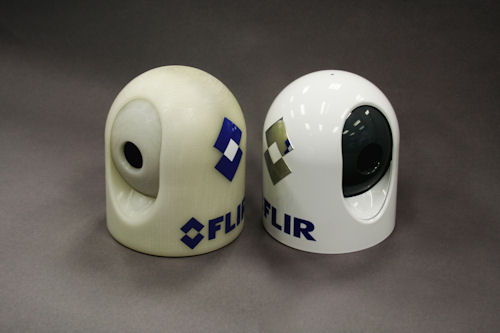 SLA printed camera housing on the left, made with Solid Concepts’ 4500 material, provided FLIR with predictions of where its final injection-molded part, on the right, might be weak in five years. This allowed FLIR to strengthen the piece and significantly lengthen product life. |
The camera, which is used for navigating at night and finding lost swimmers, has found appreciation among boat captains in particular, says Tremblay: “Many captains are on the water, driving $2 million boats at times, and now they have something akin to a car’s headlights “only better. It significantly decreases stress for them.”
The camera’s unit development, however, might be the greatest stress reliever for both user and maker. By using additive manufacturing (AM), the team at FLIR was able to inexpensively test the product before it was finalized for tooling and injection molding. Thanks to product testing early in the manufacturing process, the team succeeded in preventing the product from wearing down later in its life, and was able to better protect the thermal imaging camera from the boating environment.
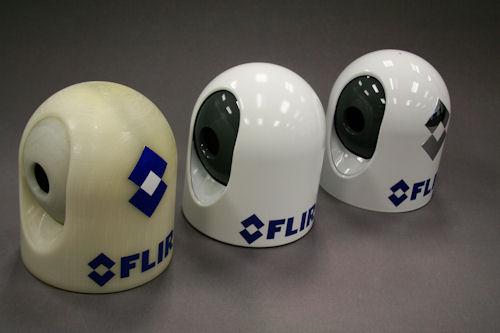 From left: SLA unfinished with logo; SLA finished camera housing; injection-molded part. |
Tremblay says FLIR never releases a production of a plastic tool without doing a stereolithography (SLA) prototype first: “It’s a rule, simple as that.”
The SLA process allows complex, involved prototypes to be built fast via preprogrammed computers, ultraviolet (UV) lasers, and liquid resins. FLIR uses service bureau Solid Concepts’ SLA technology to not only work out design intentions, but to test predicted weaknesses “essentially troubleshooting years in advance of any foreseeable problems. The multipurpose resin used for FLIR’s MD-Series camera units was SC 4500.
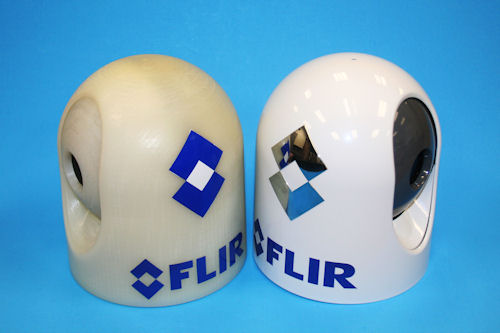 SLA camera housing beside the injection-molded housing. |
“For the MD-Series, we did water, precision of alignment and vibration testing,” Tremblay says. “The great thing about SLA plastics is that they are strong enough to endure vibration testing to a certain point. So, we put the SLA prototype unit on the boat.
“In the injection-molded final product, we know the unit will last past 1,000 shock, no problem,” he continues. “But, maybe five years down the line, the shock might cause it to break. By testing with the more fragile SLA unit, we can get an excellent idea of where the part might break down the road. Then we reinforce it in the problem areas, thereby avoiding the breakage early on and giving the product longer life. While we had successfully predicted where it might break, it was extremely important to confirm exactly where the weak point was.”
Tremblay says that FLIR does 3D models as soon as the first design is complete, usually a month-and-a-half into a new project. As soon as the CAD design is done, the team can start testing.
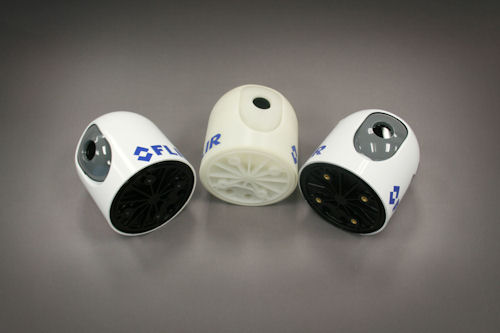 All three camera housings in various stages of the design phase. Visible are the inserts included in each part that allowed for testing and actual application to a boat for environmental testing. All three camera housings in various stages of the design phase. Visible are the inserts included in each part that allowed for testing and actual application to a boat for environmental testing. |
“We print quite a bit. For this project we had around 15 prototyped units at different times throughout the process. We also printed flexible gaskets that we used as seals for water testing. It helped us figure out any issues,” Tremblay reports. “It is useful to have the real model, to get an idea of what our logo should look like, etc. Sometimes, in CAD the logo looks good, but it is quite another thing to see in real life.”
FLIR Systems also used the prototype for another unique purpose: Preparing the assembly line.
“Prior to having all the parts done and realized, we gave our production guys the model as a guide for assembling the units. The prototype was integral in evolving the production line,” Tremblay says. “It fine-tuned the assembly process, making it efficient, fluid and quick.”
The prototype even had a run as a real product: The team at FLIR put the real thermal imaging camera into the prototype.
“The 3D model helped us figure out how to route the cable harness for the camera, how big the bends should be and how long “which was really important to finalizing the product,” Tremblay says. “Once we had it in our hands, it became apparent that the cable required length adjustments and slightly different routing.”
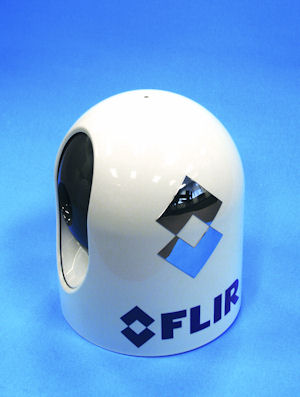 The FLIR-designed and finished injection-molded part. |
The project, which began in June, produced a fully done plastic part by August “leaving the team with just the testing of software mechanics.
“We can do analysis, but there is nothing like the real part,” Tremblay says. “Putting our camera inside the prototype and testing what the effect of the sun would be on the camera, and what the temperature of air inside the unit would be, helped us to protect the camera. It is so much better to do real testing.”
Tremblay says FLIR even used the prototype with its sales team.
“During the deign process, we printed the units and gave them to our sales force,” he explains. “We got their feedback and confirmed that the design met what they wanted. Our sales team was then able to show the unit to our key customers and ask, ‘What do you think?’ We got feedback that improved the design, and that was very good.”
Alyssa Parkinson is Marking Communications Specialist at Solid Concepts.
Info
For more information on this topic, visit deskeng.com.
Subscribe to our FREE magazine, FREE email newsletters or both!
Latest News






